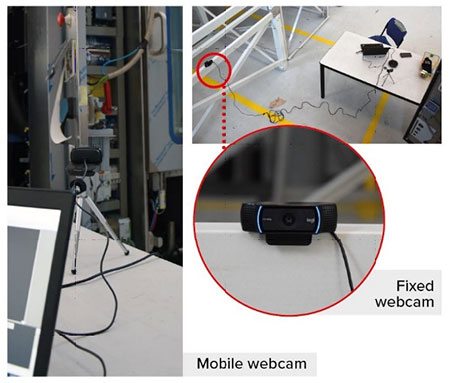Adapt and overcome – here at IWT, we continue to work with our clients to achieve successful outcomes…. Safely.
As the name suggests, FAT - Factory Acceptance Test - is generally performed at the manufacturer’s site. During a factory visit, customers verify that the equipment is built and operating in accordance with tender requirements and design specifications. This is the first step of formal acceptance from a contractual point of view, therefore it goes without saying that under no circumstances should this step of the equipment qualification process be missed.
When travelling is not possible for different reasons (lack of time; cost constraints; travel restrictions, etc), an E-FAT process is the perfect solution.
Thanks to the latest technologies, such as remote access via web based platforms, the customers can witness the different tests required by the protocol, as well as interact from a distance, asking questions and getting explanations, through the final review meeting.
Remote FAT is a smart alternative that simplifies the process, reducing the time required for staff to be away from the office and the associated costs including: travel, accommodation, visa application etc.
At IWT, E-FATs have been a consolidated practice for many years and now “Remote FAT’s” are integrated into our service offering.
It is important to note that the FAT represent the first time the customer sees the equipment fully assembled and operational after months of documentary and design work.
This first verification step of an “idea” listed in the URS that becomes “reality” allows mistakes and misunderstandings to be cleared up.
The machine is still at the supplier’s site, so any modifications can be done with minimal impact on project times and costs.
At the completion of the FAT, the green light to ship the equipment is given. This is the first step of formal acceptance from a contractual point of view, and usually represents a contractual milestone.
Therefore, it goes without saying that under no circumstances should this step of the equipment qualification process be missed. As there are often some customer constraints, different solutions can be offered by the vendor to allow the customer to attend the FAT, either at the manufacturer site or remotely.
In recent years, travelling has been straightforward, so visiting the vendor site for the FAT offers an opportunity for the customer’s representatives to see the factory and assess the manufacturing steps, including (but not limited to) processes for welding and material traceability, etc., as well as familiarize themselves with the technicians and the project teams.
 When travelling is not possible for different reasons (lack of time; cost contrains; travel restrictions, etc), an E-FAT process is the perfect solution.
When travelling is not possible for different reasons (lack of time; cost contrains; travel restrictions, etc), an E-FAT process is the perfect solution.
Thanks to the latest technologies, such as remote access via web based platforms, the customers can witness the different tests required by the protocol, as well as interact from a distance, asking questions and getting explanations, through the final review meeting.
Remote FAT is a smart alternative that simplifies the process, reducing the time required for staff to be away from the office and the associated costs including: travel, accommodation, visa application etc.
 E-FAT is based on a unified communication and collaboration digital workspace that combines chats, real-time meetings, videos and screen sharing, as well as files storage.
E-FAT is based on a unified communication and collaboration digital workspace that combines chats, real-time meetings, videos and screen sharing, as well as files storage.
By using a combination of different high-quality webcams (at least a static one, placed in front of the equipment, and a mobile one, allowing to shift the focus to different components), managed through a software normally intended for video surveillance purposes, clients can effectively enjoy the same opportunities and that sort of all-inclusive approach that they could experience travelling to IWT.
Some of the softwares and web-apps in use:

To properly run an e-FAT, we organize the activity in different steps.
- Before the FAT execution, we share with the customer the FAT protocol: it’s the starting document, which describes the agreed tests that we’ll perform during the FAT day(s).
- Then, a couple of days before the FAT, we organize a 30-minute web call to share the documents we are going to use during the FAT. These documents include the User and Maintenance manual, the PID, the pneumatic diagram, the wiring diagram, the layout, etc. During the call we take the opportunity to introduce the actors of the FAT, to know each other’s and define the goals of the next days.
- The day(s) of the FAT we start the activity at IWT in front of the machine(s): usually static tests (such as documentation checks/correspondence between the machine and the PID/wiring diagram) are performed autonomously, while functional tests (such as the washing challenge test - riboflavin, safety checks and alarms tests) are performed “live”.
During this phase the interaction among participants is very high: at IWT site, the Service engineer together with the Validation Manager and the Project manager run the machine and perform the tests on the basis of the indications received by the client. At the same time, the client witnesses all the activities asking for explanations, further details, possibility of viewing a message on the touch screen or the water at the drain during the washing cycle, etc. The FAT protocol is filled in as tests are performed: at the end of the live remote FAT, all the documentation is shared with the customer for review.
- Finally, one or two days after the e-FAT, a c losure meeting is scheduled: the customer expresses all his comments on the shared documentation and eventually approves it.
Through the years, IWT has performed several e-FATs following this methodology, always with excellent feedbacks.
What our clients say about us
